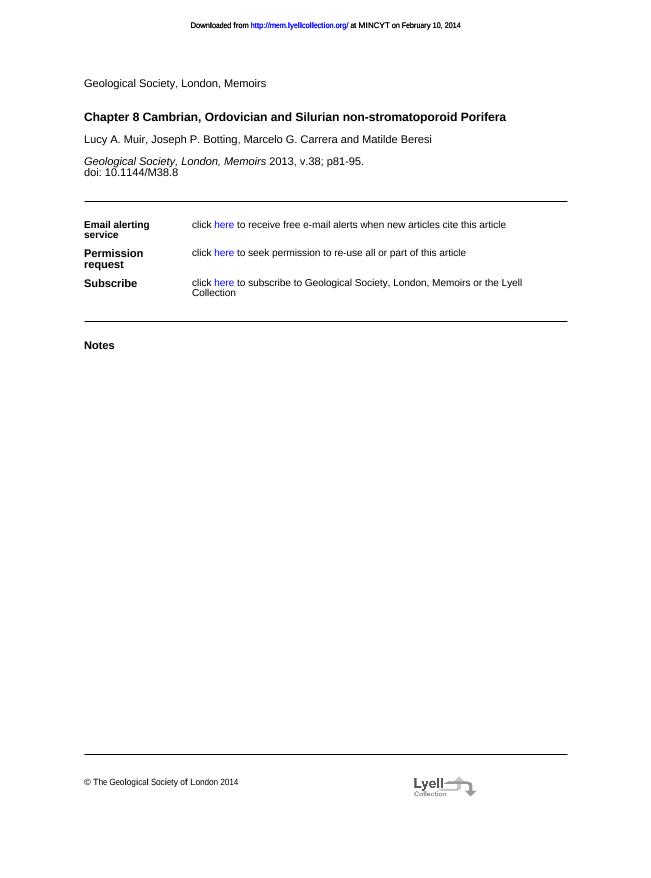Mostrar el registro sencillo del ítem
dc.contributor.author
Muir, Lucy A.
dc.contributor.author
Botting, Joshep P.
dc.contributor.author
Carrera, Marcelo Gabriel

dc.contributor.author
Beresi, Matilde Sylvia

dc.date.available
2016-05-20T15:33:47Z
dc.date.issued
2013-07
dc.identifier.citation
Muir, Lucy A.; Botting, Joshep P.; Carrera, Marcelo Gabriel; Beresi, Matilde Sylvia; Cambrian, Ordovician and Silurian non-stromatoporoid Porifera; Lyell collection; Geological Society Of London Special Publication; 38; 7-2013; 81-95
dc.identifier.issn
0305-8719
dc.identifier.uri
http://hdl.handle.net/11336/5751
dc.description.abstract
The Cambrian, Ordovician and Silurian distributions of non-stromatoporoid sponges are reviewed. The earliest Cambrian faunas contain mostly hexactinellids, with protomonaxonids dominating middle Cambrian assemblages. There are no obvious palaeobiogeographical patterns, with many genera being found widely. Vauxiids, lithistids and heteractinids are apparently confined to low latitudes, but this may be due to a poor fossil record. Most known Ordovician faunas are from low latitudes, although some high-latitude faunas are known, which contain reticulosan hexactinellids and protomonaxonids. There is some division of faunas within Laurentia, into eastern and western provinces, with the western assemblage extending across low northern latitudes during the Late Ordovician. During the Silurian Period, sponge diversity was very low during the Llandovery Epoch, probably partly owing to lack of habitat for taxa restricted to carbonate facies, and also because of sampling bias. There was a dramatic increase in diversity through the Silurian Period, mostly owing to an apparent diversification in the demosponges; however, there are many ghost lineages, indicating that their fossil record is poorly known. Non-lithistid sponges are very poorly known, with few recorded outside Euramerica. The currently available data for Early Palaeozoic sponges are too incomplete to allow any reliable palaeobiogeographical inferences.
dc.format
application/pdf
dc.language.iso
eng
dc.publisher
Lyell collection
dc.rights
info:eu-repo/semantics/openAccess
dc.rights.uri
https://creativecommons.org/licenses/by-nc-sa/2.5/ar/
dc.subject
Cambrian
dc.subject
Ordovician
dc.subject
Silurian
dc.subject
Non-Stromatoporid Sponges
dc.subject.classification
Paleontología

dc.subject.classification
Ciencias de la Tierra y relacionadas con el Medio Ambiente

dc.subject.classification
CIENCIAS NATURALES Y EXACTAS

dc.title
Cambrian, Ordovician and Silurian non-stromatoporoid Porifera
dc.type
info:eu-repo/semantics/article
dc.type
info:ar-repo/semantics/artículo
dc.type
info:eu-repo/semantics/publishedVersion
dc.date.updated
2015-11-05T13:54:41Z
dc.journal.volume
38
dc.journal.pagination
81-95
dc.journal.pais
Reino Unido

dc.journal.ciudad
London
dc.description.fil
Fil: Muir, Lucy A.. Chinese Academy of Sciences. Nanjing Institute of Geology and Palaeontology; China
dc.description.fil
Fil: Botting, Joshep P.. Chinese Academy of Sciences. Nanjing Institute of Geology and Palaeontology; China
dc.description.fil
Fil: Carrera, Marcelo Gabriel. Consejo Nacional de Investigaciones Científicas y Técnicas. Centro Científico Tecnológico Córdoba. Centro de Investigaciones en Ciencias de la Tierra; Argentina
dc.description.fil
Fil: Beresi, Matilde Sylvia. Consejo Nacional de Investigaciones Científicas y Técnicas. Científico Tecnológico Mendoza. Instituto Argentino de Nivología, Glaciología y Ciencias Ambientales; Argentina
dc.journal.title
Geological Society Of London Special Publication

dc.relation.alternativeid
info:eu-repo/semantics/altIdentifier/url/http://mem.lyellcollection.org/content/38/1/81.full
dc.relation.alternativeid
info:eu-repo/semantics/altIdentifier/doi/http://dx.doi.org/10.1144/M38.8
dc.relation.alternativeid
info:eu-repo/semantics/altIdentifier/doi/10.1144/M38.8
Archivos asociados
